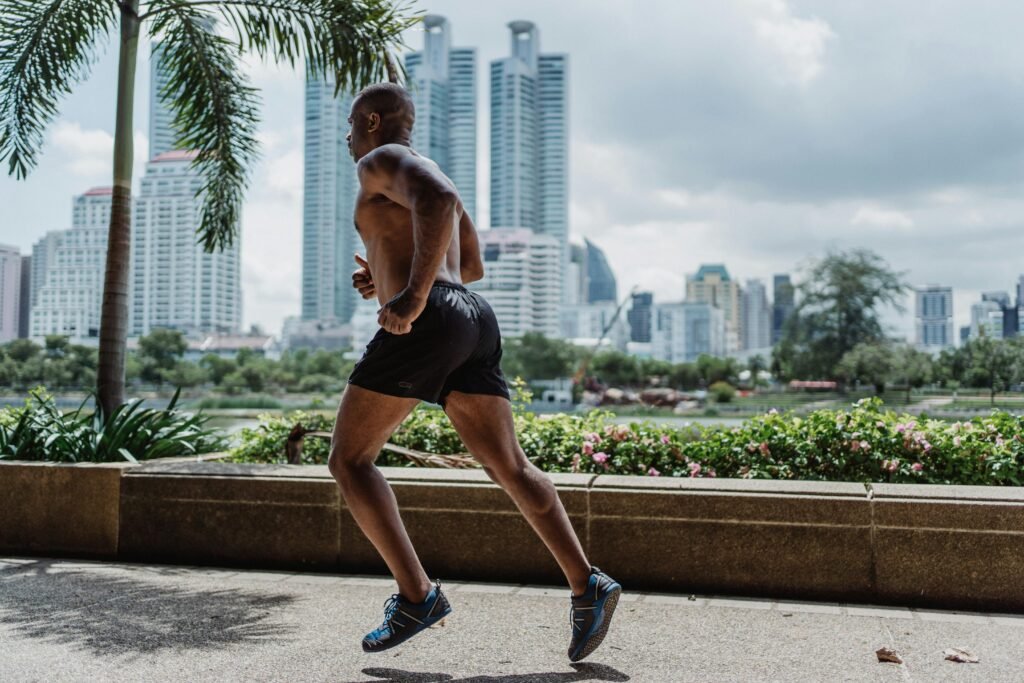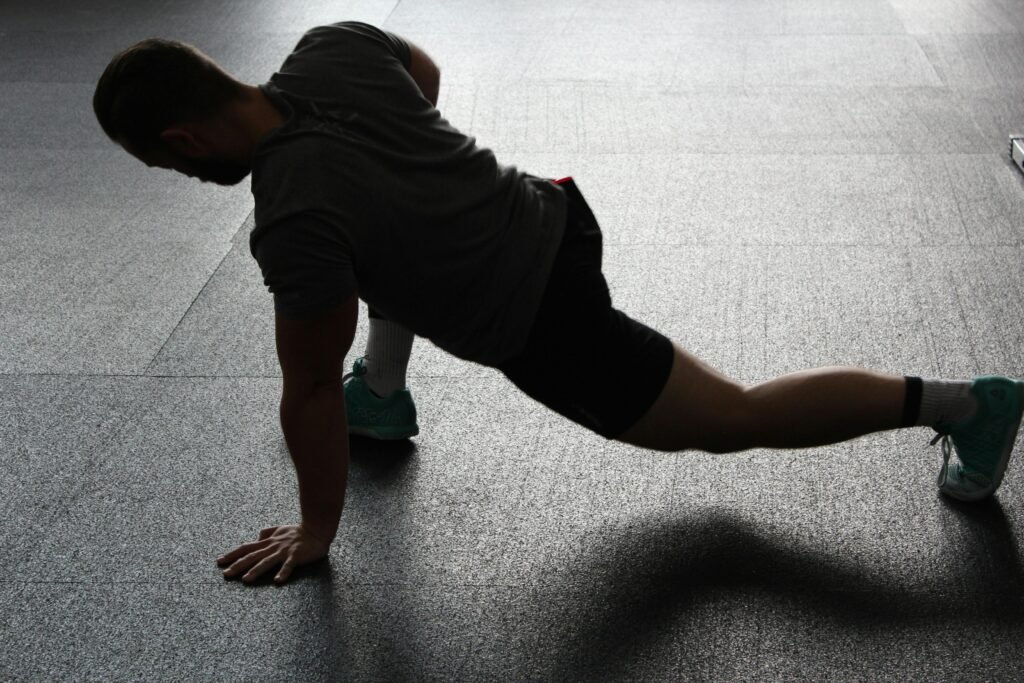Running is one of the most popular and accessible forms of exercise. Whether you’re a seasoned marathoner or just starting with a few laps around the block, running offers a multitude of benefits for your body and mind. This comprehensive guide explores the various benefits of running can have on your body, including physical, mental, and overall health benefits. We’ll delve into how running affects your cardiovascular system, muscles, bones, joints, weight, mental health, and more. By the end of this post, you’ll have a thorough understanding of why running is such a powerful and beneficial activity. So lace up your shoes, and let’s get moving!

The Physical Benefits of Running
- Cardiovascular Health
- Muscular Strength and Endurance
- Running: A Boon for Bone Health
- Weight Management
- Running Your Way to a Healthy Sexual Life
The Mental Benefits of Running
The Health Benefits of Running
How to Get Started with Running
Personal Experience Of Running
The Physical Benefits of Running
1. Cardiovascular Health
Running is a fantastic way to improve cardiovascular health. When you run, your heart rate increases, which strengthens the heart muscle and improves circulation. This leads to a more efficient heart, capable of pumping more blood with each beat. The benefits include:
👉Running: A Heart-Healthy Habit:
Running is a powerful tool for protecting your heart. Regular runs can significantly reduce your risk of heart disease by:
- Improving heart function: Running strengthens your heart muscle, allowing it to pump blood more efficiently. This reduces strain on the heart and improves overall cardiovascular health.
- Lowering blood pressure: Consistent running can help lower both systolic and diastolic blood pressure, reducing the risk of heart attacks and strokes.
- Balancing cholesterol levels: Regular physical activity helps increase “good” HDL cholesterol while decreasing “bad” LDL cholesterol, contributing to healthier arteries.
- Aiding weight management: Running is an excellent calorie burner, helping you maintain a healthy weight, which is crucial for heart health. Excess weight is linked to various heart problems.
- Reducing stress: Running is a fantastic stress reliever. Chronic stress can contribute to heart disease, so finding healthy ways to manage it is essential.
👉Running: A Boost for Your Blood Flow
Running is not just about burning calories and building endurance; it’s a powerful tool for improving your body’s circulatory system. When you lace up your running shoes, you’re not only propelling yourself forward but also enhancing the flow of life-sustaining blood throughout your body.
How Running Improves Blood Circulation:
- Heart Health: Running is a cardiovascular exercise, meaning it primarily benefits your heart. A stronger heart pumps blood more efficiently, which directly impacts overall circulation.
- Increased Blood Volume: Regular running can lead to an increase in blood volume. This means more blood is available to circulate throughout your body, delivering oxygen and nutrients to your tissues more effectively.
- Dilation of Blood Vessels: Running helps dilate blood vessels, reducing resistance to blood flow. This improved blood flow ensures that oxygen and nutrients reach even the farthest corners of your body.
- Enhanced Vein Function: Regular physical activity, including running, helps the veins in your legs function more effectively. This prevents blood from pooling in your lower extremities and promotes better circulation back to your heart.
- Improved Oxygenation: Running increases your body’s demand for oxygen. To meet this demand, your heart pumps blood faster, delivering oxygen-rich blood to your muscles and organs.
Benefits Of Better Circulation
Improved blood circulation offers a range of benefits:
- Increased energy levels: Better circulation means more oxygen and nutrients reaching your cells, leading to increased energy and reduced fatigue.
- Enhanced cognitive function: Adequate blood flow to the brain is crucial for optimal brain function, concentration, and memory.
- Faster wound healing: Improved circulation helps deliver essential nutrients and oxygen to injured tissues, promoting faster healing.
- Reduced risk of chronic diseases: Good circulation is linked to a reduced risk of heart disease, stroke, and peripheral artery disease.
👉Lower Resting Heart Rate:
A stronger heart doesn’t have to work as hard, leading to a lower resting heart rate, which is a marker of cardiovascular fitness.
2. Muscular Strength and Endurance
Running engages multiple muscle groups, particularly in the lower body legs and core. The primary muscles involved include the quadriceps, hamstrings, calves, and glutes. Over time, running can lead to significant improvements in muscular strength and endurance.
👉Will Running Make Your Legs Bigger?
The short answer: It depends.
While running does strengthen and tone leg muscles, it’s less likely to dramatically increase muscle bulk compared to weightlifting or other strength-training exercises.
Understanding Muscle Growth
To significantly increase muscle size (hypertrophy), you typically need to overload your muscles with resistance training. This means lifting weights progressively heavier over time. Running, while challenging, doesn’t provide the same level of resistance to stimulate substantial muscle growth.
The Impact of Running on Leg Muscles
- Strength and Endurance: Running primarily builds lean muscle mass, enhancing strength and endurance in your legs. This translates to better running performance, improved power, and reduced injury risk.
- Tone: Running can definitely tone your leg muscles, giving them a more defined appearance.
- Muscle Definition: Over time, as you lose body fat through running, the definition of your leg muscles may become more apparent.
Factors Affecting Leg Size
- Genetics: Your genetic predisposition plays a significant role in how your muscles respond to exercise.
- Diet: Proper nutrition, including adequate protein intake, supports muscle repair and growth.
- Intensity and Duration: While running is beneficial, the type of running you do matters. Interval training, for example, can build more muscle than steady-state running.
- Body Composition: Overall body fat percentage influences how defined your leg muscles appear.
If your goal is to significantly increase leg muscle size, incorporating legs strength training exercises like squats, lunges, and deadlifts into your routine is essential. However, if you enjoy running and want to improve leg tone and endurance, sticking to your running program can yield excellent results.
- Increased Muscle Tone: Regular running helps to tone and define muscles, particularly in the legs and core.
- Enhanced Stamina: As you run more frequently, your muscles adapt and become more efficient, allowing you to run longer distances with less fatigue.
- Strengthened Core: Running requires core stability, which helps to strengthen and tone the abdominal muscles.
👉Will Running Give You Abs?
The short answer: Running alone won’t give you visible abs.
While running is undoubtedly beneficial for overall health and fitness, achieving those coveted six-pack abs requires a more holistic approach.
Understanding the Abs Equation
- Body Fat Percentage: The visibility of your abs is primarily determined by your body fat percentage. Lowering body fat through a combination of exercise and diet is crucial to revealing those underlying muscles.
- Core Strength: Running does engage your core muscles to stabilize your body, but it’s not the most effective way to build core strength. Specific core exercises are necessary for targeted development.
How Running Can Help
- Fat Burning: Running is an excellent exercise for burning calories and reducing overall body fat, which can indirectly contribute to a lower body fat percentage.
- Core Engagement: Running requires core activation for stability, but this engagement is limited compared to dedicated core workouts.
The Path to Visible Abs
To achieve defined abs, consider incorporating the following:
- Targeted Core Exercises: Exercises like planks, crunches, leg raises, and Russian twists directly target your abdominal muscles.
- Strength Training: Building overall muscle mass can help increase metabolism and contribute to fat loss.
- Nutrition: A balanced diet with a calorie deficit is essential for reducing body fat.
- Consistency: Regular exercise and a healthy lifestyle are key to long-term success.
Remember: Genetics also play a role in how visible your abs will be. Some people naturally have a lower body fat percentage and stronger abdominal muscles.
While running is a fantastic exercise for overall health, it’s just one piece of the puzzle when it comes to achieving defined abs. A combination of targeted core workouts, core strength training, and a healthy lifestyle will give you the best results.
👉How Running Enhances Your Stamina
Running is one of the most effective ways to boost stamina. It gradually improves your body’s ability to sustain physical exertion over extended periods. Here’s how:
Building Cardiovascular Endurance
- Stronger Heart Muscle: Regular running strengthens your heart muscle, allowing it to pump blood more efficiently. This increased blood flow delivers more oxygen to your muscles, reducing fatigue.
- Increased Lung Capacity: As your lungs work harder to supply oxygen during runs, they become more efficient at oxygen exchange. This improved lung capacity allows you to breathe more deeply and sustain exertion for longer.
Improving Muscle Efficiency
- Enhanced Muscle Fiber Development: Running develops both slow-twitch and fast-twitch muscle fibers. Slow-twitch fibers are responsible for endurance, while fast-twitch fibers contribute to speed and power. A balance of both is crucial for stamina.
- Increased Lactate Threshold: Running helps your body become more efficient at clearing lactic acid, the byproduct of intense exercise. A higher lactate threshold means you can push harder before experiencing fatigue.
Mental Toughness
- Overcoming Challenges: Running often involves pushing through discomfort. This mental fortitude translates to improved stamina in other areas of life, as you learn to persevere through challenges.
3. Running: A Boon for Bone Health
Running is a weight-bearing exercise that can significantly contribute to improved bone density.
👉How Does It Work?
- Impact and Stress: When you run, the repetitive impact on your bones stimulates bone-building cells called osteoblasts. These cells work to strengthen and thicken bone tissue in response to the stress placed upon it. This process is known as Wolff’s Law.
- Hormonal Influence: Running can also influence the production of hormones that promote bone growth, such as calcitonin and parathyroid hormone.
👉Key Factors for Bone Health Benefits
- Intensity and Duration: While running is beneficial, the intensity and duration of your runs matter. A mix of high-impact and low-impact activities can be optimal for bone health.
- Overall Exercise Routine: Incorporating other weight-bearing exercises, like strength training, can further enhance bone density.
- Nutrition: Adequate calcium and vitamin D intake is essential for bone health.
👉Important Considerations
- Overtraining: Excessive running can actually have a negative impact on bone health. It’s crucial to balance running with rest and recovery.
- Individual Differences: The impact of running on bone density can vary depending on factors like age, gender, and genetics.
Remember: While running is beneficial, it’s essential to consult with a healthcare professional before starting a new exercise regimen, especially if you have concerns about bone health.
4. Weight Management
Can Running Help You Lose Weight?
Absolutely! Running is a fantastic way to burn calories and contribute to weight loss.
👉How Running Aids Weight Loss
- Calorie Burn: Running is a high-intensity exercise that burns a significant number of calories during and after your workout (known as the afterburn effect).
- Appetite Control: Regular running can help regulate appetite hormones, potentially reducing cravings and overall food intake.
- Muscle Building: While not as effective as weightlifting, running can help build lean muscle mass, which boosts metabolism and aids in fat burning.
👉Key Factors for Weight Loss Success
- Caloric Deficit: To lose weight, you need to consume fewer calories than you burn. Running helps increase calorie expenditure, but it’s essential to combine it with a balanced diet.
- Consistency: Regular running is key. Aim for at least 150 minutes of moderate-intensity exercise per week.
- Variety: Incorporate different types of running, such as interval training or hill workouts, to challenge your body and prevent plateaus.
- Overall Health: Prioritize sleep, hydration, and stress management for optimal weight loss results.
👉Realistic Expectations
It’s important to remember that weight loss is a journey, and results vary from person to person. Focus on progress, not perfection, and celebrate non-scale victories like increased energy and improved mood.
5. Running Your Way to a Healthy Sexual Life
While it might seem surprising, running can significantly contribute to a healthier and more fulfilling sexual life. Let’s explore how:
Enhanced Physical Performance
- Increased Stamina: Regular running boosts your overall endurance, translating to better performance in the bedroom.
- Improved Blood Circulation: Running enhances blood flow throughout your body, including to the genital area. This can lead to improved sensitivity and responsiveness.
- Boosted Confidence: Achieving fitness goals through running can boost self-esteem and body image, positively impacting sexual confidence.
Reduced Stress and Anxiety
- Stress Relief: Running is a proven stress-buster. Chronic stress can negatively impact libido and sexual performance.
- Better Sleep: Regular exercise often leads to improved sleep quality. Adequate sleep is crucial for overall well-being, including sexual desire.
The Mental Benefits of Running
1. Stress Relief
Running is a powerful stress reliever. Physical activity stimulates the production of endorphins, the body’s natural mood elevators.
- Endorphin Release: Often referred to as the “runner’s high,” the release of endorphins during a run can create feelings of happiness and euphoria.
- Reduced Anxiety: Regular running can help reduce anxiety and promote a sense of calm and well-being.
- Improved Sleep: Running can improve sleep quality by helping you fall asleep faster and enjoy deeper, more restorative sleep.
2. Mental Clarity and Focus
Running can also enhance mental clarity and cognitive function. The rhythmic and repetitive nature of running can have meditative effects, helping to clear your mind and improve focus.
- Enhanced Cognitive Function: Running increases blood flow to the brain, which can improve memory, concentration, and overall cognitive function.
- Boosted Creativity: Many runners find that running helps them think more creatively and solve problems more effectively.
- Mental Resilience: The discipline and perseverance required for running can translate into greater mental resilience in other areas of life.
3. Improved Mood
Running has a profound impact on mood and overall mental health. It is often used as a tool to combat depression and other mood disorders.
- Combat Depression: Running can help alleviate symptoms of depression by increasing the production of neurotransmitters like serotonin and norepinephrine, which are involved in regulating mood.
- Increased Self-Esteem: Achieving running goals and seeing physical improvements can boost self-esteem and confidence.
- Social Connection: Running can also be a social activity, providing opportunities to connect with others and build supportive relationships.

The Health Benefits of Running
1. Immune System Boost
Regular running can strengthen your immune system, making you less susceptible to illnesses.
- Enhanced Immune Function: Moderate running increases the circulation of immune cells in the body, helping to fight off infections and diseases.
- Reduced Inflammation: Running helps to reduce chronic inflammation, which is linked to various health conditions, including heart disease and cancer.
2. Longevity
Running has been linked to increased lifespan. Studies have shown that regular runners tend to live longer than non-runners.
- Extended Lifespan: Running reduces the risk of many chronic diseases, such as heart disease, diabetes, and certain cancers, contributing to a longer, healthier life.
- Improved Quality of Life: Running helps maintain physical and mental health, ensuring a higher quality of life as you age.
3. Better Respiratory Health
Running enhances lung capacity and respiratory function.
- Increased Lung Capacity: Regular running strengthens the respiratory muscles, increasing lung capacity and improving overall respiratory health.
- Improved Oxygen Utilization: Running enhances the efficiency of the body’s oxygen utilization, improving endurance and performance in other physical activities.
How to Get Started with Running
1. Setting Realistic Goals
Before you start running, it’s essential to set realistic goals. Whether you aim to run a specific distance, improve your pace, or lose weight, having clear goals will keep you motivated and focused.
- Start Small: If you’re new to running, begin with short, manageable distances and gradually increase your mileage.
- Track Your Progress: Use a running app or journal to track your progress and celebrate your achievements.
- Stay Consistent: Consistency is key to reaping the benefits of running. Aim to run at least three times a week.
2. Proper Running Gear
Investing in the right running gear can make a significant difference in your running experience.
- Running Shoes: Choose running shoes that fit well and provide adequate support and cushioning.
- Comfortable Clothing: Wear moisture-wicking, breathable clothing to stay comfortable during your runs.
- Safety Gear: If you run at night or in low-light conditions, wear reflective gear to stay visible to drivers and other runners.
3. Warming Up and Cooling Down
Warming up before a run and cooling down afterward are crucial steps to prevent injury and promote recovery.
- Warm-Up: Spend 5-10 minutes doing dynamic stretches or light jogging to prepare your muscles and joints for running.
- Cool Down: After your run, spend another 5-10 minutes doing static stretches to relax your muscles and improve flexibility.
4. Listening to Your Body
It’s essential to listen to your body and avoid pushing yourself too hard, especially when you’re starting.
- Rest and Recovery: Allow your body to recover between runs to prevent overtraining and injury.
- Hydration and Nutrition: Stay hydrated and fuel your body with a balanced diet to support your running routine.
- Injury Prevention: Pay attention to any signs of discomfort or pain and address them promptly to avoid serious injuries.
Personal Experience Of Running
Hey there! I’m Zahir (Writer), a 30-year-old running enthusiast. People often tell me I look pretty fit and ask how I manage to stay in shape. Well, let me share my incredible running journey!
Eight years ago, I was a total mess – stressed, anxious, and feeling pretty low. That’s when I decided to give running a try. I couldn’t even run for five minutes without gasping for air! It was tough, but I kept at it, gradually increasing my running time by two or three minutes each day. Before I knew it, I was running for 30 minutes straight, and then an hour! It was amazing how running helped to melt away my stress and anxiety.
Now, running is a huge part of my life. I love hitting the treadmill, exploring parks in the morning, or squeezing in a run on my way home from work. At first, running outside was a bit daunting, but I’ve grown to love it! I’ve even completed a half-marathon! Running has become my second love (my wife is number one, of course!).
It’s done wonders for my physical and mental health. I feel stronger, happier, and more alive. Running is now my daily dose of happiness!
Conclusion
Running offers a multitude of benefits for your body and mind. From improving cardiovascular health and strengthening muscles to boosting mood and mental clarity, the positive impacts of running are extensive. By setting realistic goals, investing in proper gear, and listening to your body, you can enjoy the many rewards that running has to offer. Whether you’re looking to improve your fitness, manage weight, or enhance your overall well-being, running is a powerful and accessible tool that can help you achieve your goals. So lace up your running shoes, hit the pavement, and experience the transformative power of running.




Fantastic beat I would like to apprentice while you amend your web site how could i subscribe for a blog site The account helped me a acceptable deal I had been a little bit acquainted of this your broadcast offered bright clear concept